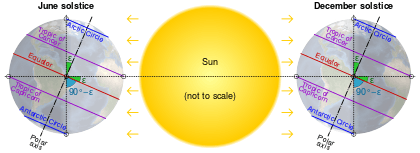Antarctic Circle

The Antarctic Circle is one of the five major circles (or parallels) of latitude that mark maps of the Earth. As of 22 January 2016, it runs 66°33′46.1″ [1] south of the Equator.
Description
The area south of the Antarctic Circle is known as the Antarctic, and the zone immediately to the north is called the Southern Temperate Zone. The equivalent line of latitude in the northern hemisphere is the Arctic Circle.
The Antarctic Circle is the northernmost latitude in the Southern Hemisphere at which the sun can remain continuously above or below the horizon for 24 hours. Every place south of the Antarctic Circle experiences at least one whole day each year during which the sun does not set, and at least one whole day during which the sun does not rise. A period of twenty-four hours' continuous daylight occurs at least once per year as does a period of twenty-four hours' continuous night time. On the Antarctic Circle these events occur, in principle, exactly once per year, at the December and June solstices respectively. This happens because the Earth's axis is tilted, by approximately 23.5 degrees, relative to ecliptic (the plane of the Earth's orbit around the sun). At the southern winter solstice, the southern hemisphere is tilted away from the Sun to its maximum extent, and the region of permanent darkness reaches its northern limit; at the southern summer solstice, the southern hemisphere is tilted towards the Sun to its maximum extent, and the region of permanent sunlight reaches its northern limit.
The Antarctic Circle marks the northern extremity of the southern hemisphere 24-hour sunlit day, and 24-hour sunless night at sea level. Because of atmospheric refraction, mirages and because the sun appears as a disk and not a point, part of the midnight sun may be seen on the night of southern summer solstice up to about 50′ (90 km (56 mi)) north of the Antarctic Circle. That is true at sea level; those limits increase with elevation above sea level, and in mountainous regions, there is often no direct view of the true horizon. Mirages on the Antarctic continent tend to be even more spectacular than in Arctic regions, creating, for example, a series of apparent sunsets and sunrises while in reality the sun remains under the horizon.
Due to gradual changes in the tilt of the Earth's axis, the Antarctic Circle is slowly moving. It is currently moving southward at a rate of approximately 15 metres (49 ft) per year. See circles of latitude for further details.
The area south of the Antarctic Circle is about 20,000,000 km2 (7,700,000 sq mi) and covers 4% of the Earth.[2] The Antarctic Circle is 17,662 km long. [3]

Geography and demographics
The continent of Antarctica forms a land mass covering much of the area within the Antarctic Circle. There is no permanent human population south of the Antarctic Circle. There are, however, several Antarctic research centers from many nations that are inhabited by teams of scientists that rotate on a seasonal basis. In previous centuries, some semi-permanent whaling stations were established on the continent and some of the whalers would live there for a year or more. At least three children have been born in Antarctica, albeit in stations north of the Antarctic Circle. See Demographics of Antarctica.
Starting at the Prime Meridian and heading eastwards, the Antarctic Circle passes through:
See also
References
- ↑ obliquity of the ecliptic (Eps Mean)
- ↑ Physical Geography: Great Systems and Global Environments by William M. Marsh, Martin M. Kaufman
- ↑ BBC website, accessed Jan 3, 2016
External links
| ||||||
